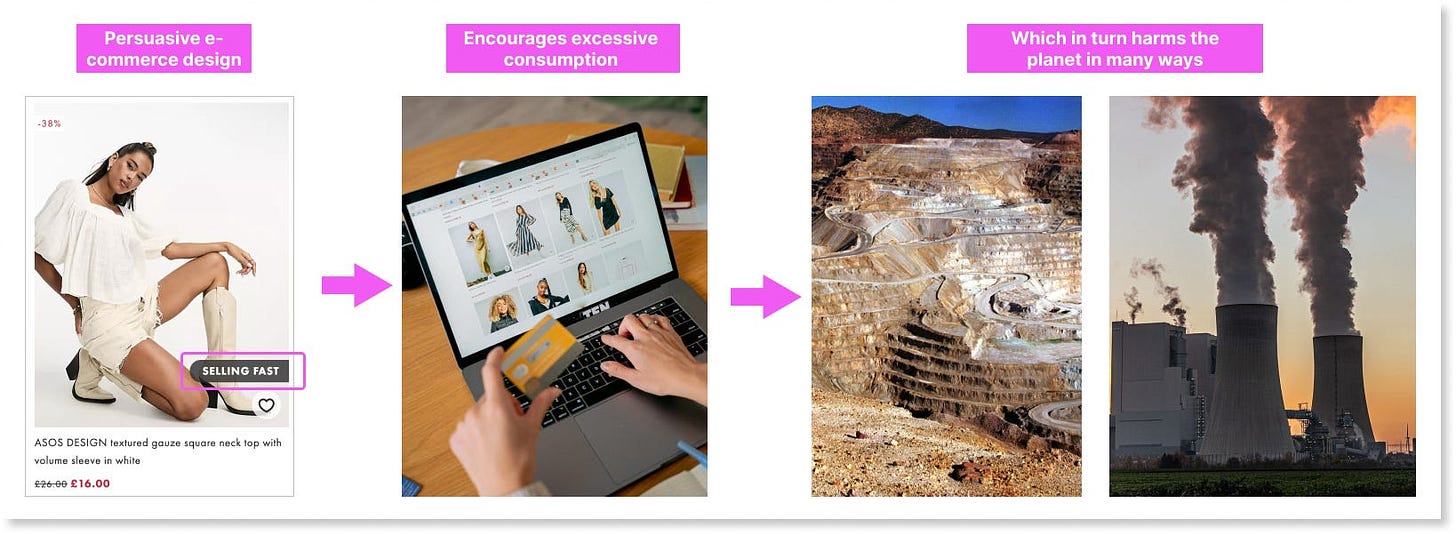The negative impact of persuasive design
Why the discussion around the detrimental impact on the user and the environment is non-existent.
E-commerce websites use messages like “Only one left in stock, hurry!” and other persuasive design techniques for one sole purpose: to get the user to buy more. While there have been many articles written about how these techniques serve the business (aka more sales), the discussion around the detrimental impact on the user and the environment is non-existent. Until now.
E-commerce is all about sales, baby!
The success of an e-commerce store comes down to one thing: how much it sells. Just look at the sales-focused key performance indicators (KPIs) that are used to measure the success of an e-commerce site: average order value, cart abandonment rate, sales conversion, etc.
Increasing the amount of money a user spends and decreasing the chance they are leaving empty-handed is the ultimate goal. The whole company works in unison to make that happen. Including UX.
Part of a UX designer’s job is to contribute to achieving the KPIs. The designer is expected to deliver designs that will increase the average order value and decrease cart abandonment rate. In other words, use design tools to get the user to buy more.
One of these tools is persuasive design.
Persuading the user to buy more
Persuasive design uses psychology and behavioral insights to influence the user’s behavior and decisions. The goal is to elicit the behavior desired by the persuader. Here is an example:
“Social proof is a technique to get people to buy a particular product or buy more. As marketers have come to learn about how strong a persuasive power social proof has on consumer behavior, they ensure to make their consumers believe that other people also purchase and like their product. “
Social proof is just one example, but we can think about personalization, urgency, framing, and recommendations as persuasive design tools. I’m working on a comprehensive overview of these techniques and until I can link to that I recommend reading the paper titled: Persuasive Systems Design: Key Issues, Process Model, and System Features (Oinas-Kukkonen and Harjumaa, 2009) to better understand the taxonomy of persuasive design.
The bottom line is: we have meaningful knowledge about human behavior and psychology we can apply in our designs to “encourage” our users to buy more. And while the business might be happy to see the average order value going up, there are other aspects to this that we rarely think about.
Persuasion encourages excessive consumption
Since we are encouraging our users to buy more, buy bigger, buy newer…Buy things they don’t even want or need in the first place, we can safely say that persuasive UX design encourages excessive and unnecessary consumption.
I want to emphasize when I say excessive consumption I mean the consumption of meaningless stuff that doesn’t bring value to our lives. Think Temu the home of chicken-shaped lamps and toilet paper holders in the shape of a smiling velociraptor. Think Shein where you can buy any fashion fad for so cheap that it feels okay to throwaway them away after one use. Think Flying Tiger, the equivalent of if Temu had a physical store: useless trinkets and knickknacks for literally no money.

Excessive consumption is destroying the planet
Excessive consumption is one of the leading causes of environmental degradation and climate change. We take our limited natural resources to produce all the stuff we don’t need, just to send them to the landfill in a short while. Polluting and destroying the environment during production and disposal of course.

The more we consume, the more we contribute to the already devastating environmental situation.
Consequently, the more we encourage unnecessary and excessive consumption, the more we contribute to the already devastating environmental situation.

If this revelation about the environmental impact of persuasive design didn’t make you interested in reconsidering their usage, there is another perspective that might. Something we designers say we care about the most: the user.
Persuasive design is detrimental to the user too
Luckily there is a recent (2022) OECD paper detailing the negative impact of e-commerce persuasion on users, so I’m just going to lift the key points here.
Persuasion might compromise user autonomy since the choice architecture and visual presentation of options can “lead consumers to make choices they may not otherwise have made”. Users usually have the illusion of control, when in reality there is an arsenal of tools applied throughout the entire shopping experience to influence their decisions.
Financial loss since these persuasive patterns aim “getting consumers to buy something that they may not have needed or to spend more than they may have otherwise intended.”
Negative emotions since the user can feel frustration, shame, or guilt for being tricked or manipulated.
Cognitive burden as the user has to exercise extreme willpower and concentration in order to make sensible decisions.
So your users would also be better off if they were not constantly persuaded to BUY MORE.
Let’s sum this up shall we: persuasive design in e-commerce increases sales (yey for the business), while it contributes to environmental problems and negative user sentiments.
We should care about this because…
E-commerce is a growing business: ~20% of the world's retail sales are now online, equating to $6 trillion in sales in 2022. The projection is that this spending is going to grow to ~$8 trillion by 2026. Today 2.5 billion people shop online, but it will be closer to 3 billion by 2025.
Big numbers but the bottom line is: we shop so much online and it is only going to grow in the future. And apparently, persuasive design is responsible for a big chunk of this online shopping:
Using FOMO (urgency or scarcity principles) can boost conversions by 40%-200%. (source)
Online product reviews (social proof) about a specific product can increase conversion rates by 270%.
A study shows that 18 to 28-year-olds were 65% more likely to spend more than intended owing to persuasive patterns (OECD report).
E-commerce is a significant part of life and economy and it is here to say. But for the sake of a liveable future, we must change how we design it.
As responsible designers, we need to recognize that we have an overconsumption problem. That our work is the enabler and accelerator of unsustainable user behavior. In the middle of an environmental crisis, we can’t design for unsustainable behavior.
As long as we only look at design decisions through a user-centered lens it is easy to overlook the wider, indirect impact of our designs.
When feel the world burning around us (literally) it is a good indication that it is time to start not to ignore the problems we are part of creating.
What do we do?
We come together and demand change! We say no to using persuasive design in online shopping experiences, and we call out companies that still do. We talk to fellow designers about the problem and engage top voices in the design community to raise awareness.
As I said before, discussion and awareness about this particular problem is non-existent. I’m working on filling this gap, and in the meantime, I would love to connect with you who got ideas and motivation to change things after this article. Let’s connect on LinkedIn.
Just to finish the article on a positive note, here is a rough outline of the concept I’m working on:
Kind Commerce
Kind Commerce is a persuasion-free online shopping experience where we give users the space and opportunities to make mindful purchase decisions. We don’t compromise usability, findability, or aesthetics, but we refuse to nudge for excessive consumption.
It’s kind to our users and our planet.
I’m working on all kinds of resources (articles, manifesto, practical guides, examples etc.) that I’m going to release as they get ready.
So keep an eye out and share this article to help get the ball rolling!






